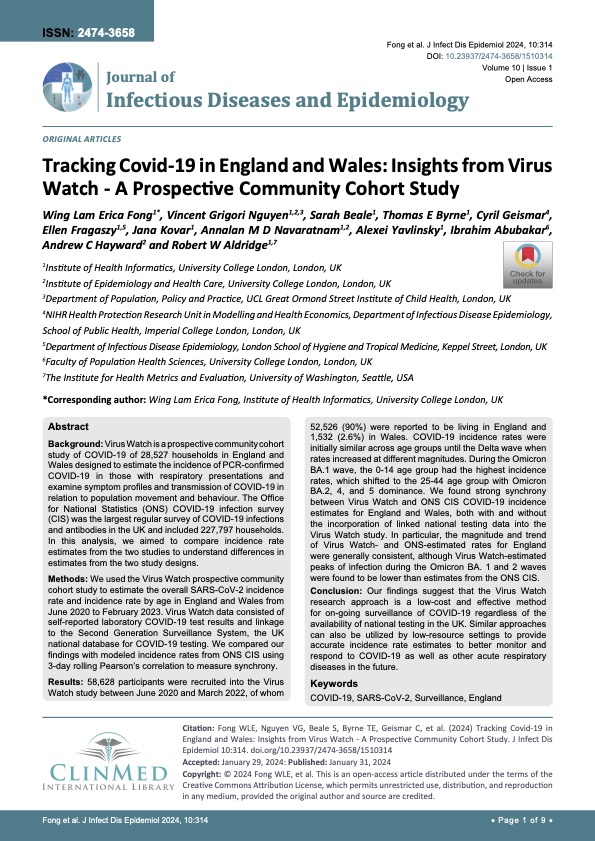Publication links
Abstract
Background: Virus Watch is a prospective community cohort study of COVID-19 of 28,527 households in England and Wales designed to estimate the incidence of PCR-confirmed COVID-19 in those with respiratory presentations and examine symptom profiles and transmission of COVID-19 in relation to population movement and behaviour. The Office for National Statistics (ONS) COVID-19 infection survey (CIS) was the largest regular survey of COVID-19 infections and antibodies in the UK and included 227,797 households. In this analysis, we aimed to compare incidence rate estimates from the two studies to understand differences in estimates from the two study designs.
Methods: We used the Virus Watch prospective community cohort study to estimate the overall SARS-CoV-2 incidence rate and incidence rate by age in England and Wales from June 2020 to February 2023. Virus Watch data consisted of self-reported laboratory COVID-19 test results and linkage to the Second Generation Surveillance System, the UK national database for COVID-19 testing. We compared our findings with modeled incidence rates from ONS CIS using 3-day rolling Pearson’s correlation to measure synchrony.
Results: 58,628 participants were recruited into the Virus Watch study between June 2020 and March 2022, of whom 52,526 (90%) were reported to be living in England and 1,532 (2.6%) in Wales. COVID-19 incidence rates were initially similar across age groups until the Delta wave when rates increased at different magnitudes. During the Omicron BA.1 wave, the 0-14 age group had the highest incidence rates, which shifted to the 25-44 age group with Omicron BA.2, 4, and 5 dominance. We found strong synchrony between Virus Watch and ONS CIS COVID-19 incidence estimates for England and Wales, both with and without the incorporation of linked national testing data into the Virus Watch study. In particular, the magnitude and trend of Virus Watch- and ONS-estimated rates for England were generally consistent, although Virus Watch-estimated peaks of infection during the Omicron BA. 1 and 2 waves were found to be lower than estimates from the ONS CIS.
Conclusion: Our findings suggest that the Virus Watch research approach is a low-cost and effective method for on-going surveillance of COVID-19 regardless of the availability of national testing in the UK. Similar approaches can also be utilized by low-resource settings to provide accurate incidence rate estimates to better monitor and respond to COVID-19 as well as other acute respiratory diseases in the future.
Keywords
Citation
Fong WLE, Nguyen VG, Beale S, Byrne TE, Geismar C, et al. (2024) Tracking Covid-19 in England and Wales: Insights from Virus Watch – A Prospective Community Cohort Study. J Infect Dis Epidemiol 10:314. doi.org/10.23937/2474-3658/1510314

